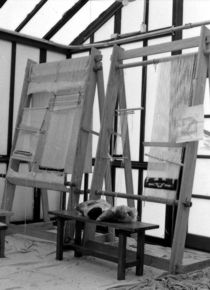Gurdjieff International Review
Studying an Ancient Tradition
Mary Stein
The weaving team at St. Elmo[1] was for “older women,” I had heard Lord Pentland say, and so I felt a certain satisfaction in being assigned to the team, led by Barbara Wright, not long after I began going to St. Elmo on Sundays. At the same time, something in me had a question: what might it mean—I was still in my 30s—to be an “older woman”? What was possible for an “older woman” to learn and also to contribute on the weaving team?

I followed the steps on the path leading down through the garden to the weaving shed, a greenhouse-like structure of heavy translucent plastic panels fastened to a sturdy wooden frame. Inside the shed several looms seven or eight feet high bore knotted rugs—then the main kind of weaving—in various stages of completion.
We paired off in front of the looms, two women to each loom, each one knotting half a row—the woman on the left starting at that end, the woman on the right starting in the middle. At the end of each row we’d pass a weft thread across, then beat it down into the firm knots we’d just tied. There was a rhythm to be discovered; before long, without haste, we’d find such a rhythm and reach the end of our appointed half of the row at the same time. We also got to observe our habitual competitiveness, which gradually came to serve the rhythm we had found.
Weaving required an alert mind; a mistake meant breaking the rhythm with one’s partner, as well as the rhythm of the pattern. We stayed on the qui vive for the emerging design, the indigo knot that moved over one or two places from row to row, as a double arrow, traditional animal or geometric shape appeared in the weaving. A certain watchful intelligence was the order of the day, and I came to understand why the Greeks had put the warrior-goddess and strategist Athena in charge of weaving. Given the complexity of the patterns we were working on, it was no wonder that the weaving shed was a quiet place where “older women” refrained from speaking more than was necessary.
As we worked at the looms, we were aware that the subtle colors of the wool for the knots had often been achieved by other members of the team working with materials found in the natural world—walnut shells or oak galls for brown, indigo for the darkest blue, madder and cochineal for red, marigold or onionskins for yellow. Natalie Conradi, long a member of the team, devoted years of her retirement to studying the intricacies of dyestuffs and dyeing. Our awareness of the prolonged experience that had gone into preparing the wool brought depth to our work of weaving.
We took a turn now and then at drawing designs for weaving and pored over books that pictured old rugs, particularly nomad rugs, from the Middle East—Turkey, Persia, the Caucasus. We pondered the guls and winged goddesses, the step-arrow-pyramids, the octagon-sun-star-flowers, the linked medallions rising like linked worlds. What had they meant to those people? How much had been lost as the symbols were used more automatically, as no doubt they had been? How much was still available to an attentive look? Was it possible, as one’s body participated in weaving the traditional designs, knot by knot, row by row, that an understanding might appear from the work we did together, an ancient teaching revealing itself?
~ • ~
Photo circa 1968 by Paul Kagan.
| Copyright © 2012 Gurdjieff Electronic Publishing Featured: Spring 2012 Issue, Vol. XI (1) Revision: April 1, 2012 |
[1] The Gurdjieff Foundation in San Francisco was located for many years on St. Elmo Way.